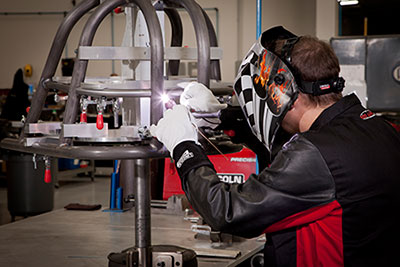TIG Welding Chrome-Moly Tubing
Here are answers to the top ten most frequently asked questions about TIG welding 4130 Chrome-Moly. These attached procedures apply to typical sporting applications such as experimental airplanes, racing car frames, roll cages, go-carts, bicycles, and motorcycle frames. The suitability of these techniques and procedures must be evaluated for your specific application.
Q. Can I weld 4130 using the TIG process?
A. Yes, 4130 Chrome-Moly has been TIG welded in the aerospace and aircraft industries for years. As with all welding, proper procedures and techniques must be followed.
Q. Do I need to pre-heat?
A. Thin wall tubing (< 0.120" wall) applications do not typically require the normal 300ºF to 400ºF pre-heat to obtain acceptable results. However, tubing should be at room temperature (70ºF) or above before welding.
Q. What filler material do I use? A. Although there are several good filler materials, ER80S-D2, is one you should consider. This filler material is capable of producing welds that approximate the strength of 4130. ER70S-2 is an acceptable alternative to ER80S-D2, as is ER70S-6, although the weld strength will be slightly lower.

A. Yes. The filler material, when diluted with the parent material, will typically undermatch the 4130. However, with the proper joint design (such as cluster or gusset, for example), the cross-sectional area and linear inches of weld can compensate for the reduced weld deposit strength.
Q. Why is 4130 filler metal not recommended?
A. 4130 filler is typically used for applications where the weld will be heat treated. Due to its higher hardness and reduced elongation, it is not recommended for sporting applications such as experimental airplanes, race car frames, roll cages, etc.
Q. Can I weld 4130 using any other filler metals?
A. Some fabricators prefer to use austenitic stainless steel fillers to weld 4130 tubing. This is acceptable provided 310 or 312 stainless steel fillers are used. Other stainless steel fillers can cause cracking. Stainless filler material is typically more expensive.
Q. Do I need to heat treat (stress relieve) 4130 after welding?
A. Thin wall tubing normally does not require stress relief. For parts thicker than .120", stress-relieving is recommended and 1,100ºF is the optimum temperature for tubing applications. An Oxy/Acetylene torch with neutral flame can be used. It should be oscillated to avoid hot spots.
Q. Do I have to pre-clean 4130 material?
A. Remove surface scale and oils with mild abrasives and acetone. Wipe to remove all oils and lubricants. All burrs should be removed with a hand scraper or de-burring tool. Better welding results with clean materials.
Q. Do I need to back-purge 4130 material?
A. Backpurging is not normally necessary, although some fabricators do. It will not hurt the weld and may improve the root pass of some welds.
Q. Should I quench the metal after I finish welding?
A. ABSOLUTELY NOT! Rapid quenching of the metal will create problems such as cracking and lamellar tearing. Always allow the weld to slow cool.
WELDING SPECIFICATION: Aircraft and Motorsports
General Information:
- Remove all oxides and burrs within 3" of weld area
- Acetone wipe to remove all cutting oils
- Assemble and tack weld in joint in a minimum of four (4) places with TIG
- Tubing should be at minimum temperature of 70ºF (room temperature
- TIG weld per parameters specified using a Lincoln Electric Precision TIG® welder.
Example Weld Schedule Information
| PARENT MATERIAL: | 4130 |
| MATERIAL CONDITION: | Condition (N) |
| MATERIAL THICKNESS: | .035" Wall Thickness |
| FILLER MATERIAL: | ER80S-D2 .035" Diameter |
| JOINT TYPE: | 90º Tube to Tube. |
| JOINT PREP: | Abrasive Clean/Acetone Wipe |
| JOINT GAP: | .000-.010 |
| CURRENT TYPE: | D.C.E.N. (DC Electrode Negative) |
| AMPERAGE: | 20 - 40 amps |
| VOLTAGE: | 9-12 Volts |
| TORCH TYPE: | PTA-9 or PTW-20 Magnum® Pro-Torch™ TIG Torch |
| CUP SIZE: | Gas Lens 7/16" Orifice |
| CUP TYPE: | Ceramic |
| TUNGSTEN TYPE: | 2% Thoriated |
| TUNGSTEN SIZE: | 1/16" Diameter |
| TUNGSTEN SHAPE: | Pointed |
| TORCH GAS: | Argon |
| FLOW RATE: | 15-25 C.F.H. |
| BACK-UP GAS: | Argon |
| FLOW RATE: | 5-10 C.F.H. |
| TACKING SEQUENCE: | 4-Places (min.) |
Filler Material Options:
| Option #1 | ER80S-D2 |
| Option #2 | ER70S-2 |
| Option #3 | ER70S-6 |
FOOTNOTE: Welding properties change from operator to operator. Techniques such as travel speed, filler type, filler deposition rates, current (amperage), gas shielding, and arc voltage (distance between tungsten and weld puddle) all have an effect towards heat input, weld strength, and elongation.
